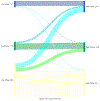Patient-reported Primary Care Video and Telephone Telemedicine Preference Shifts During the COVID-19 Pandemic
- PMID: 37733433
- PMCID: PMC10592113
- DOI: 10.1097/MLR.0000000000001916
Patient-reported Primary Care Video and Telephone Telemedicine Preference Shifts During the COVID-19 Pandemic
Abstract
Background: Patient perceptions of primary care telephone and video telemedicine and whether COVID-19 pandemic-related telemedicine exposure shifted patients' visit preference is unknown.
Objectives: We examined patient surveys to understand the health care experience of patients seeking primary care through telemedicine and how patients expected their preferences to shift as a result of the COVID-19 pandemic.
Research design/subjects: In an integrated delivery system that shifted to a "telemedicine-first" health care model during the COVID-19 pandemic, we sampled monthly and collected 1000 surveys from adults with primary care telemedicine visits scheduled through the online patient portal between 3/16/2020 and 10/31/2020.
Measures: Participants reported their preferred primary care visit modality (telephone, video, or in-person visits) across 3 time points: before, during and (hypothetically) after the COVID-19 pandemic, and reported their general assessment of primary care visits during the pandemic.
Results: The majority of participants preferred in-person visits before (69%) and after the COVID-19 pandemic (57%). However, most participants reported a preference for telemedicine visits during the pandemic and continue to prefer telemedicine visits at a 12% higher rate post-pandemic. Many participants (63%) expressed interest in using telemedicine at least some of the time. Among participants reporting a recent telemedicine visit, 85% agreed that the visit addressed their health needs.
Conclusion: As primary care visit modality preferences continue to evolve, patients anticipate that they will continue to prefer telemedicine visits, both video and telephone, at an increased rate than before the COVID-19 pandemic.
Copyright © 2023 Wolters Kluwer Health, Inc. All rights reserved.
Conflict of interest statement
The authors declare no conflict of interest.
Figures



Similar articles
-
Demographic and technological factors influencing virtual seizure clinic visit satisfaction before and during the Covid-19 pandemic in rural Hawaii.Epilepsy Behav. 2021 Oct 7;124:108374. doi: 10.1016/j.yebeh.2021.108374. Epub 2021 Oct 7. Epilepsy Behav. 2021. PMID: 34757265 Free PMC article.
-
Telemedicine and visit completion among people with HIV during the coronavirus disease 2019 pandemic compared with prepandemic.AIDS. 2022 Mar 1;36(3):355-362. doi: 10.1097/QAD.0000000000003119. AIDS. 2022. PMID: 34711737 Free PMC article.
-
Downstream Emergency Department and Hospital Utilization Comparably Low Following In-Person Versus Telemedicine Primary Care for High-Risk Conditions.J Gen Intern Med. 2024 Oct;39(13):2446-2453. doi: 10.1007/s11606-024-08885-6. Epub 2024 Jul 12. J Gen Intern Med. 2024. PMID: 38997530
-
Falls prevention interventions for community-dwelling older adults: systematic review and meta-analysis of benefits, harms, and patient values and preferences.Syst Rev. 2024 Nov 26;13(1):289. doi: 10.1186/s13643-024-02681-3. Syst Rev. 2024. PMID: 39593159 Free PMC article.
-
Lessons from the pandemic: a retrospective study and literature comparative review of provider and patient experiences with telemedicine in spine care.J Neurosurg Spine. 2025 Apr 11;43(1):122-137. doi: 10.3171/2025.1.SPINE24959. Print 2025 Jul 1. J Neurosurg Spine. 2025. PMID: 40215617
Cited by
-
Primary Care Telemedicine and Care Continuity: Implications for Timeliness and Short-term Follow-up Healthcare.J Gen Intern Med. 2024 Oct;39(13):2454-2460. doi: 10.1007/s11606-024-08914-4. Epub 2024 Jul 17. J Gen Intern Med. 2024. PMID: 39020223
-
Introducing a Simple Tool of Patient Self-Assessment of Wrist Range of Motion.Life (Basel). 2024 Aug 10;14(8):997. doi: 10.3390/life14080997. Life (Basel). 2024. PMID: 39202739 Free PMC article.
-
Oral mucosal disease: dilemmas and challenges in general dental practice.Br Dent J. 2024 Feb;236(4):269-273. doi: 10.1038/s41415-024-7080-x. Epub 2024 Feb 23. Br Dent J. 2024. PMID: 38388596 Free PMC article.
-
Higher than expected telemedicine use by racial and ethnic minority and cognitively impaired Medicare beneficiaries.Health Aff Sch. 2025 Jan 29;3(1):qxae175. doi: 10.1093/haschl/qxae175. eCollection 2025 Jan. Health Aff Sch. 2025. PMID: 39882151 Free PMC article.
-
Patterns of Telemedicine Use in Primary Care for People with Dementia in the Post-pandemic Period.J Gen Intern Med. 2024 Nov;39(15):2895-2903. doi: 10.1007/s11606-024-08836-1. Epub 2024 Jul 24. J Gen Intern Med. 2024. PMID: 39046633 Free PMC article.
References
-
- Chang JE, Lindenfeld Z, Albert SL, et al., Telephone vs. Video Visits During COVID-19: Safety-Net Provider Perspectives. J Am Board Fam Med, 2021. 34(6): p. 1103–1114. - PubMed
-
- Friedman AB, Gervasi S, Song H, et al., Telemedicine catches on: changes in the utilization of telemedicine services during the COVID-19 pandemic. Am J Manag Care, 2022. 28(1): p. e1–e6. - PubMed
MeSH terms
Grants and funding
LinkOut - more resources
Full Text Sources
Medical
Research Materials

